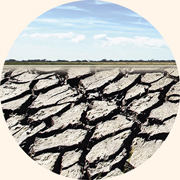 At a time when Bangladesh and India are gasping for breath under the searing sun, some desert nations in the Middle East are encountering deluge caused by heavy rains accompanied with thunder and sandstorms. The highest temperature recorded so far in Bangladesh was on Monday when it hit the 43 degree Celsius mark with several areas scorching under 40 degree Celsius temperature for days together. India recorded its highest temperature at 45.2 degree Celsius in Odisha---straightway 7.1 degree Celsius more than the normal, with West Bengal following close by at 45.1 degree Celsius on Saturday last, which is 8.3 degree Celsius above the normal.
At a time when Bangladesh and India are gasping for breath under the searing sun, some desert nations in the Middle East are encountering deluge caused by heavy rains accompanied with thunder and sandstorms. The highest temperature recorded so far in Bangladesh was on Monday when it hit the 43 degree Celsius mark with several areas scorching under 40 degree Celsius temperature for days together. India recorded its highest temperature at 45.2 degree Celsius in Odisha---straightway 7.1 degree Celsius more than the normal, with West Bengal following close by at 45.1 degree Celsius on Saturday last, which is 8.3 degree Celsius above the normal.
While the heat waves are responsible for disrupting and even claiming lives mostly due to heat strokes in wider swathes of South Asia, Pakistan's Khyber Pakhtunkhwa, like some of the Arab states of the Persian Gulf, have gone under floods following unremitting heavy rains for four days at a stretch and also melting of glaciers. As many as 59 people died in this unforeseen natural disaster.
In a similar turn of Nature's caprice, desert countries from United Arab Emirates (UAE) to Saudi Arabia to Oman have experienced heavy rains, in some areas accompanied with thunderstorms. This has triggered unprecedented floods in those three Gulf countries. The world's second busiest airport, according to the 2023 ranking, and Abu Dhabi's major highways went under water because of record rainfalls on April 16 and 17 last, causing severe disruption to flights at this major hub. As high as 250 millimetre (mm) of rainfall was recorded in less than 24 hours --- all-time high since logging precipitation began in 1949. Just imagine the 100 mm rainfall in just 12 hours, which is equivalent to an entire year's rainfall around Dubai!
Many parts of Saudi Arabia including Makka and Riyadh also suffered submersion enough for the cars to float on flood water. Excessive rains forced closure of schools, colleges and universities including King Khaled University on Sunday and Monday. Strong winds, heavy rainfall and standstorms also struck Jeddah awfully limiting visibility. Oman located on the eastern edge of Arabian peninsula suffered the highest casualties with 18 people perishing in the deluge. Bahrain and Qatar also experienced rainfalls.
But it is southern China, Guangdong to be precise, that has been overwhelmed by record-breaking rains. Densely populated Pearl River delta including the megacity of Shenzhen was engulfed by severe floods killing four people and forcing evacuation of tens of thousands of inhabitants from the affected area. By Monday last 110,000 people were evacuated and 25,800 others moved to emergency shelters. This current emergency is not the only crisis China faces, 45 per cent of China's urban land has been sinking faster than 3.0mm a year with 16 per cent at more than 10 mm a year, according to the journal Science. This is not due only to declining underground water tables but also because of the sheer weight of the overall human settlements.
Such extreme weather events and consequent danger of inundation of cities is not typical of China alone. Another study published in February last warned that around 6.3 million square kilometre of land across the globe was at risk of sinking under water. Indonesia finds itself among the worst hit with large part of Jakarta already staying below sea level. In this context Tokyo which had suffered subsidence of about 5.0 metre before it banned extraction of groundwater in the 1970s offers a lesson for the 44 major coastal cities, 30 of which are in Asia, facing the problem.
The slew of weather extremes are not an undesirable specialty of this year alone. Europe and North America smarted under rise in mercury and heat domes respectively. In fact, 2023 was the warmest year recorded. Maybe, the year 2024 will break that record. The floods and other bizarre weather phenomena such as snowfall in Arabian deserts are interconnected with the heat waves in South Asia and unprecedented rise in temperature in colder Europe and other places. A warmer planet means disruption in weather patterns originating, among others, in the Pacific and Indian Oceans. Under the El Nino, strange things are happening and behind all such phenomena lies the climate change to which human contribution is the main culprit.
Confronting the threat of losing 12-17 per cent of its land in the country's coastal south, Bangladesh has formulated its National Adaptation Plan (NAP) 2023-2050. Under the Paris Agreement at the UN Climate Change Conference (COP21), it is incumbent on the 196 parties to comply with the legally binding dos and dont's but so far the big powers have paid more lip service than acting. Instead of reducing CO2 emission aimed at arresting temperature rise to 1.5 degree Celsius above the pre-industrial level, the big powers are now arming themselves to the teeth. This is reflected in the rise in defence budgets of all major players. But they feel no qualms for reneging on their commitment of giving $100 billion every year to climate-vulnerable countries for adaptation and mitigation of vulnerability. There will be no ivory tower for even the richest nations to stay immune from climate backlash if misplaced priorities such as war expenditure take over climate adaptation, research in and innovation of technology for clean energy that holds key to cooling the planet.
© 2024 - All Rights with The Financial Express
